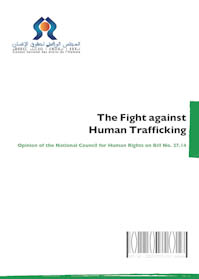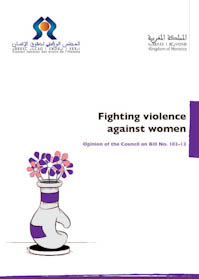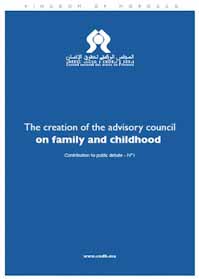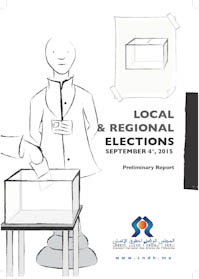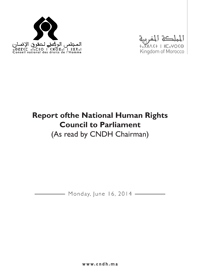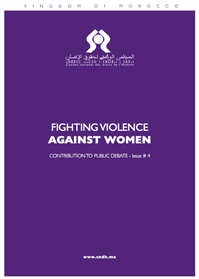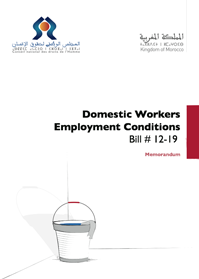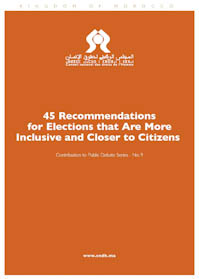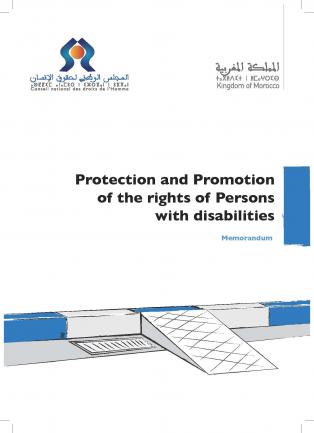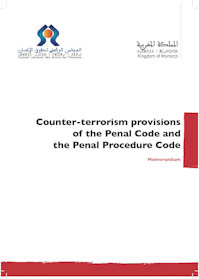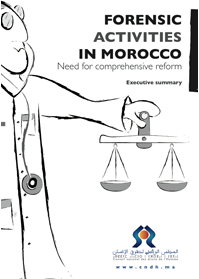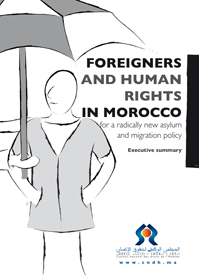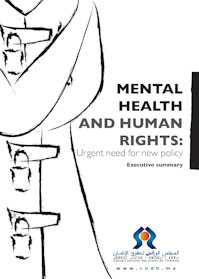Study on the right to development in Morocco
Background, Objectives and Methodology Respect for human rights as an essential framework in achieving any development policy is a principle widely recognized since the Millennium Declaration adopted by the UN General Assembly in September 2000. Section V of this declaration is entitled "Human rights, democracy and good governance". Section III reiterates and reinforces the statement on "the Right to Development" adopted on 4 December 1986. This close links between human development and human rights has facilitated the conclusion of a partnership agreement between the Advisory Council on Human Rights (CCDH) and the United Nations Development Programme (UNDP). The Council gives a special interest to economic, social and cultural rights (ESCR). They are the basis of the Council’s new approach now. The UNDP, for its part, stresses the importance of the existing links between the ESCR and the Millennium Development Goals (MDGs), the monitoring and implementation of which are assumed by the Programme. The references and principles of the two parties are closely linked. The MDGs advocate the promotion of development and gender approach and the International Covenant on ESCR advocate the right to a decent life and non-discrimination. Besides, the Covenant stipulates that the signatories undertake to work towards the implementation of the Covenant’s rights. The MDGs are a roadmap to achieve tangible results. The Moroccan public arena is experiencing an increase of socio-economic (employment, health, basic services, education, etc.) and cultural (including language) demands. It is due to the impetus and efforts of civil society stakeholders. With these efforts such demands keep increasing which indicates that the "right to development", in its broadest sense, will be the major challenge of the Moroccan public debate in the future. Poverty and exclusion, which affect a part of the Moroccan population, are no longer ignored. Better yet, a strategy to combat them has gradually taken shape through significant efforts in terms of budget allocation for social sectors (53% in 2009 against 39% in 1993), the establishment of development agencies and the launch of several programs (the urgent social program, the National Initiative for Human Development, Governance Support Program, etc.). In this context and in light of these findings, CCDH, in partnership with the UNDP, launched a study devoted to the "Right to development in Morocco." This study does not address all ESCR covenant’s rights or the entire MDGs. It is dedicated to employment, education, health and housing. These rights are subject to increasing demands. They are essential for social stability and a priority whenever the annual budget is to be decided. OBJECTIVES The main objective of the study is the promotion of the integration of human right in the public decision making processes and, correspondingly, in the public policies and programs related to human development. Respect for human rights and development cannot be divided. Their interdependence underpins all areas of activity: economic, political and cultural. The second objective is to initiate a national debate around the possibilities to develop methods and mechanisms for monitoring human rights progress, stagnation and possible setbacks in Morocco. We want to measure the impact of public policies on social progress, not only through development indicators but also in view of human rights reference. METHODOLOGY The methodology adopted for this study is based primarily on the analysis of data, available documentation and interviews. This analysis is based on the intersection of the MDGs and the rights of the International Covenant on ESCR in relation to the four relevant sectors. The study aims to establish a diagnosis of the four sectors. It examines then the sectoral public policies in terms of availability, accessibility, acceptability and adaptability. It focuses on the achievements, gaps and deficiencies, with special attention to the most vulnerable categories of the population. EDUCATION AND THE RIGHT TO EDUCATION ACCESS TO EDUCATION Nearly the third of children accessing the first year of the primary education have no preschool education. Only a third went to a kindergarten, while others have been to Quran teaching schools (msid). The current system of primary school is not suitable for children with mental or physical disability and children of nomads and mountain enclaves. Children spend too much time studying too fragmented curriculum that cannot help them develop useful and viable skills. A model of schools with more diverse curriculum focusing on fundamental competencies will undoubtedly help reach better results. GOVERNANCE Strengthening the prerogatives of academies and schools may lead to: - A more rigorous enforcement of laws and regulations relating to the compulsion of schooling, pedagogical aspects, transparency in resource management, the fight against school dropout and other local scope scourges; - Better coordination within sectors and across sectors and with local stakeholders; - A new dynamic and innovation in solving problems of accessibility, acceptability and adaptability of school infrastructure, equipment and educational services, on the one hand, and the adequacy of training for local socio-economic requirements, on the other. LEGAL CONTEXT A critical examination of the legal framework of education reveals the following: The provisions of laws and regulations are not all enforced with the necessary rigor; Some recurring problems are due to the lack of legal and regulatory frameworks, such as the financial management of school institutions, the fight against illiteracy, non-formal education, the regulation of strikes and some aspects of the professional ethics of education such as overtime pay, violence in schools and the psychological support to students by unqualified teachers. Some aspects of the financial management of school institutions are still governed by decrees dated back to the protectorate era. MONITORING AND ASSESSMENT Strengthening the prerogatives of regional education and training academies and their autonomy should be accompanied by the establishment of a system for periodic assessment of the performance of educational institutions and decentralized administrative structures. The lack of such system compromises the achievement of the expected results and the promotion of best governance results based practices. It delays the introduction of monitoring and control systems for the achievement of the results. EMPLOYMENT AND THE RIGHT TO WORK ACCESS TO EMPLOYMENT - In general, we note the continuing disparities in access to employment and income between urban and rural areas, between regions and also between specific categories. The growth of the economic activity does not result in an equitable distribution of income between rural and urban areas, between regions and between the categories of the population; - Between 1990 and 2007, the incidence of extreme poverty ($ 1/day) declined, while poverty ($ 2 / day) has stabilized around 15%. The progress in poverty reduction is slower in rural areas, and in three regions, particularly the provinces concerned by the Program of Social Priorities (BAJ); - Poverty affects women and children, due to the disparities in employment status and the few opportunities to engage in a productive activity. Factors that impede progress in the fight against poverty and the chances of access to jobs and income are highlighted; - Inequalities in consumption and access to income have stabilized or increased slightly between 2000 and 2007; - Inequalities between the 20% richest and the 20% poorest witnessed no improvement between 2000 and 2007; - The fifth of the poorest has moved from 6.6% in 1990 to 6.5% in 2007; - Inequality is higher in urban areas and more accelerated in three regions; - Access to the minimum wage, social protection and labor management remains limited to formal sector workers and a tiny minority of the informal sector; - The system is poorly adapted to small and medium enterprises and micro-enterprises in the informal sector and the agricultural sector; - No unemployment benefits, low coverage of pension plans (private sector and the informal sector), non-respect for the Employment Code, especially in the informal sector; - Regarding specific categories, unequal access of women to income remains due to their low employment rates and their dominant status as unpaid family workers (78.7% rural); - Progress achieved in the education of women does not have proportional impact on the improvement and promotion of their employment; - Child labor has declined, but it is still persisting in rural areas; - Working children are the most exposed group to wage discrimination, especially girls working as maids; - Discrimination against the persons with disabilities in access to employment and social protection persists, despite quotas regulations. The low rate of the elderly who have a retirement pension. GOVERNANCE - Regarding poverty, constraints still limit interaction in reducing poverty. These include, among other, low dynamic job creation, the fragility of economic growth, limits of policies, income inequalities; - The analysis of wage policy identifies some deficiencies and a decline in social benefits; - Wage flexibility, which is at the heart of the wage policy of the State, is supposed to be incentive for hiring and economic growth. But, in fact, it opposes the right o work, human development and growth itself. The low level of growth is not unrelated to the weak demand which is itself the result of low wages. The development model linked to the external markets do not help creating sustainable protected jobs; - The same governance gaps related to ANAPEC. Recruitment liberalization does not support the effective and transparent control and sound management of the job market; - Similarly, the deficits of governance of pension funds are highlighted, in particular, financial difficulties and the weakness of regulation that encourages non-declaration of employees; - In the field of workplace safety and hygiene, the deficits persist despite the progress achieved at the regulatory level. These deficits vary according to sectors and cities; - A higher rate of accidents is registered in Fez, Marrakech and Casablanca in the textile and construction industries; - This situation is aggravated by shortages recorded in training of labor inspectors, human and material resources and awareness of different stakeholders; -Problems of coordination between the different stakeholders and the institutions in policies making and in their implementation and monitoring. LEGAL CONTEXT Despite advances, such as the improvement of regulations and working conditions and the improvement of the social climate, gaps still persist. In general, the national labor regulations apply only to the employees of the public sector and large enterprises. Small businesses in the informal sector are not governed by the regulatory system, for lack of resources, non-adaptation to the existing regulations and acceptance of a sector that creates precarious jobs. There is also the low rate of registration of formal sector employees in the National Social Security Fund (CNSS). There is no compliance with the quota of 7% of jobs reserved for people with disabilities in the civil service and the partial compliance with laws on maternity protection, in addition to the weak enforcement of regulations prohibiting the employment of children under 15 and their exploitation in hazardous work. In the same vein, we note the absence of legislation on freedom of association and the right to strike, the weak enforcement of regulations on hygiene and health, in particular, in the informal sector (14% companies with more than 50 employees have a health committee). A key conclusion is that there is a need to reconcile two legitimate concerns: the necessity of competitiveness for firms that are forced to operate a perpetual change and the need for safety and protection of rights of employees. Such a balance is difficult to achieve particularly in light of constraints that limit the right to association, among these constraints the non-ratification of Convention No. 87 on freedom of association is the most important. MONITORING AND ASSESSMENT The absence of control and monitoring limits effectiveness and undermines the role of job market institutions. In general, monitoring is limited due to the lack of resources needed to ensure it. For example, the monitoring of respect for working conditions, social protection, and occupational health requires strengthening the work of inspectors and doctors. HEALTH AND THE RIGHT TO HEALTH The health sector has strengths and weaknesses reflected in the access to care, the sector's governance, its regulatory context and its evaluation. It is important to note the overall positive impact of progress on the health condition of the population. The achievements in this field are reflected in the degree of the major socio-economic indicators: the rate of population growth (1.4%), the total fertility rate (2.5 children per woman) and life expectancy at birth (72 years on average). Thanks to the significant decrease in mortality rate among children, the sharp reduction in the prevalence of several communicable diseases, including the elimination of the most deadly diseases and to the remarkable extension of public and private health care provision, including the development of response capabilities of health professionals. ACCESS TO HEALTH CARE Despite the gains, the health sector still has significant shortcomings, often exacerbated by geographical and categorical inequalities. Categorical inequities are more common for vulnerable groups (women, children, elderly and disabled). They are reflected in the differences between regions and areas (urban, suburban and rural), particularly in the allocation of human resources, basic health facilities and government funding. The global public and private offer is characterized by weak complementarities between the two sectors. This offer does not allow the establishment of a balance between the different regions and provinces in terms of basic health services. The rate of maternal and infant mortality in Morocco is one of the highest in the world, with obvious disparities between regions and between urban and rural areas. It is primarily due to the unfavorable conditions of deliveries. Many women still give birth at home, far from any medical supervision, which is still weak even in the delivery units affiliated to the Ministry of Health. The poorest, especially in rural areas, face many challenges (economic, geographic, socio-cultural...) to access health care services, which are, medically and para-medically, unequally distributed. Health care services are below the requirements for some diseases, including diabetes, cancer, kidney failure, mental health and cardiovascular diseases. The number of people living with HIV / AIDS, while under treatment, increase sharply. Access to health care varies widely according to the income levels. The poor populations use public services while the more affluent opt for private services. Poor people are largely excluded from health insurance. The richest urban populations benefit from public hospitals about seven times more than the poorest urban populations, while in rural areas low and middle income populations use more health facilities where treatment is free. This situation is aggravated by other external factors associated with illiteracy, poor housing, unemployment and job insecurity, in addition to sex-based discrimination. LEGAL FRAMEWORK The Moroccan law contains a number of texts that guarantee the right to health. The legislative and regulatory arsenal, however, remains inadequate and sometimes incomplete or outdated. The existing laws do not reflect a national health policy and nor the existence of a national health system. Moreover, the mechanism put in place does not include the entire health structures and measures, namely: Public and private hospital facilities characterized by slow adaptation to changes and requirements of the development of the sector. Health programs, hospital organization and the assertion of the rights of patients, particularly the right to ensure confidentiality and maintain the medical record of the patient, etc. GOVERNANCE Health authorities have multiplied efforts to adapt health activities to the socio-economic development, in order to correct inequalities in access to health, caused by the incessant budget deficits, and to reduce the effects of the financial crisis suffered by the social sectors in general and the health sector in particular. Local authorities and households permanently called for the participation and contribution to the fundraising efforts, improving health services, extend social security and set a medical coverage under the finance reform. Despite the ongoing reform program, there are significant deficiencies in the governance of the sector, including: - Deficiency in collaboration and coordination, which affects the Ministry’s internal structures and its relationships with other sectors; - Hypertrophy of the central administration and the modesty of material and human resources and services at the provincial level; - Establishment of health legislation is monopolized by the public administration; the private sector's role is almost absent. This monopoly is accentuated by an "administrative centralism" in the management of the health system and planning of health programs. This results in other governance problems, namely: - No policy for human resources management, resulting hence in the unequal distribution of health professionals across the country and the concentration of a large part of human resources in the axis of Rabat-Casablanca; - Disparity in the distribution of the public and private healthcare structures between the different regions; - Underfunding of the health system. The total health expenditure remains well below the requirements, which constitutes an obstacle to the development of the sector; - No real drug policy; - Deficiencies in the management of public hospitals in particular: the centralization of administrative management, lack of coordination with health centers at the provincial level, lack of managerial competence in hospitals; inadequate available techniques and human resources put in place to operate them, etc.; - Existence of other phenomena, such as absenteeism, corruption, poor patient reception, etc. MONITORING AND ASSESSMENT In this area, the essential is the periodic assessment conducted through a national health information system for the collection of data needed to monitor health activities at the central and local levels. If necessary, this assessment system will be supplemented by occasional studies and field surveys. The shortcomings of this area are due to the absence of necessary control within a context dominated by illegal practice of medicine, waste of resources, absenteeism, corruption in care facilities and the weakness of social programs and means of motivation in the sector. HOUSING AND THE RIGHT TO HOUSING The housing issue in Morocco refers, on the one hand, to the existing housing units, their characteristics and forms of occupation and to the production of housing units according to their modes, forms and actors, on the other. The sector registered a remarkable dynamism during the period of 2003-2007, which led in particular to the acceleration of the pace of production of authorized units, from 81 670 units in 2000 to 110 810 in 2006. Despite the performance recorded in the sector, the housing sector deficit remains large. The number of units built each year is around 120 000 while the deficit is estimated at some 600,000 units. The legislative framework: the sector is regulated by several laws and regulations dated back to the period of the protectorate. Since then, efforts have been made at this level to adapt laws to the evolution of society, but the legal arsenal introduced at the period of the protectorate has not yet been adapted to the rapid changes of the sector. In many cases, there is a discrepancy between the provisions and the reality, or at least a difficulty to follow the transformations in the sector of housing. It is the case of laws relative to housing, subdivisions and real estate properties. The public policies: public interventions have taken different forms, including the pace of public resources mobilization. Despite the made efforts and the improved performance in conducting and controlling operations, significant gaps remain in the implementation of housing programs among the Kingdom’s regions and cities. Their impact is related to more reparation and correction actions rather than to development policies. The analysis of the housing sector highlights the progress of the sector and the shortcomings and constraints that hinder access to adequate housing. This analysis was focused on four concepts: accessibility, governance, legislative framework and monitoring and evaluation. ACCESS TO HOUSING - In terms of access to adequate housing for low-income populations, undeniable efforts have been made, but delays and disparities between regions, communities, neighborhoods, etc. persist; - Deficiencies are widely known, especially in rural areas and suburbs of large cities. Despite the overall improvement in housing conditions, there are some differences between urban and rural areas and between regions; - Increased financial resources have been mobilized for housing, but their assignment indicates an uneven distribution between urban and rural areas and among regions; - The last decade has witnessed the acceleration in the production of housing units in conformity with the recognized standards, but also the persistence of substandard housing units and other forms of inadequate housing that affect primarily low-income populations; - Access to decent housing for low-income households is still an objective to be achieved in some territories, to reduce disparities in access to housing in the different regions, urban and rural areas and neighborhoods; - Progress was certainly made and various mechanisms were put in place to see improve access to housing, with the ultimate objective of providing adequate housing, especially to the lower income populations; - But the magnitude of the deficit of this sector, the increasing needs and the difficulty of targeting lower income groups through public programs make the achievement of this objective difficult. GOVERNANCE The State action in the housing sector takes several forms: mobilization of public lands, allocation of financial, technical and operational resources that contribute to the improvement of housing production and allow large access through specific programs targeting low-income households. But the sector still faces many shortcomings that limit the impact of public interventions, including: - Differences between the regions despite the significant achievements in terms of housing units (lots, homes). Casablanca, for example, has not yet achieved the objectives of the "Cities without Slums” program, despite the fact that substandard housing units are widespread in this city; - Distance resettlement sites in relation to areas of activities and services despite the mobilization of public properties for housing operations, which poses problems of integration due to the lack of efficient transport means; - Excessive concentration of resources in the hands of a single public operator, to the detriment of local specificities and the diversity of approaches, despite a strengthening control of the public project; - Importance of achievements in terms of quantity but little progress made in terms of urban and architectural quality in terms of adaptation to the environmental conditions and cultural practices of the inhabitants; - The housing issue is addressed on a sectoral basis and is insufficiently integrated into a comprehensive vision of territorial development. The implementation of housing programs requires interdepartmental coordination at the central level and focus on local consultation for the operations. LEGAL CONTEXT The right to housing is not explicitly mentioned in the Moroccan legal texts, but the country has laws and regulations that organize and supervise the housing sector. Overall, this legal arsenal is constantly adapted, but the approval rate of laws is very slow, in addition to several difficulties in terms of application. It is the case of town planning code, operational planning and relationships between landlords and tenants. Besides, there is a relaxation of construction licensing procedures and special exceptional procedures relative the planning documents to promote investment in social housing in particular. But this inadequately supervised relaxation resulted in significant shortcomings relative to the urban planning and urban development coherence. We must emphasize the absence of provisions that take into consideration the specificities of housing units attended for some social groups (elderly, disabled). MONITORING AND ASSESSMENT The housing sector is regularly monitored at the central level, based on local data of the regional inspectorates of habitat and the observatories dedicated to the housing sector. However, this monitoring is often reduced to the physical and quantitative aspects of the programs and deals with the socio-economic aspects and urban integration only in terms of operational obstacles to the realization of projects. We must emphasize the lack of permanent assessment to accompany the implementation of programs. The few assessment studies, often conducted through partnership with donors, lead to results that are not examined adequately by the different stakeholders.





